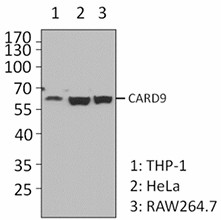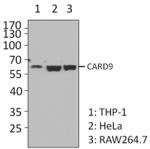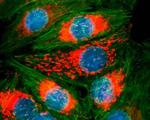- Clone
- 13D9C60 (See other available formats)
- Regulatory Status
- RUO
- Other Names
- Caspase Recruitment Domain-Containing Protein 9, CANDF2, hCARD9
- Isotype
- Mouse IgG2a, κ
- Ave. Rating
- Submit a Review
- Product Citations
- publications

-

Total cell lysates from THP-1 cells (lane 1), HeLa cells (lane 2), and RAW264.7 cells (lane 3) were resolved by electrophoresis, transferred to nitrocellulose, and probed with purified monoclonal CARD9 (clone 13D9C60) antibody. Proteins were visualized using a HRP-conjugated anti-mouse-IgG secondary and chemiluminescence detection. -

HeLa cells were fixed with 2% (PFA) for ten minutes, permeabilized with 0.5% Triton X-100 for five minutes, and blocked with 5% FBS for 30 minutes. Then the cells were intracellularly stained with 2 µg/mL anti-CARD9 Antibody (clone 13D9C60) followed by Alexa Fluor® 594 (red) conjugated goat anti-mouse IgG in blocking buffer for two hours at room temperature. Actin filaments were labeled with Alexa Fluor® 488 Phalloidin (green). Nuclei were counterstained with DAPI (blue). The image was captured with a 60X objective.
| Cat # | Size | Price | Quantity Check Availability | Save | ||
|---|---|---|---|---|---|---|
| 679102 | 100 µg | 249€ | ||||
Caspase recruitment domain-containing protein 9 (CARD9) is a member of the CARD protein family, which is known to play regulatory roles in cell apoptosis. CARD9 is an adaptor protein that mediates the signaling downstream of C-type lectin receptors (CLRs), such as Dectin-1, Dectin-2, and Mincle. CARD9 also participates in the signaling downstream of the Retinoic acid-inducible gene I receptor (RIG-1) family. After stimulation of the receptors, CARD9 is phosphorylated and forms a trimolecular complex with B cell leukemia-lymphoma 10 (Bcl10) and mucosa-associated lymphoid tissue 1 (Malt1), which activates the canonical NF-κB pathway and leads to the induction of proimflammatory cytokines, including IL-6, IL-1β, and tumor necrosis factors-alpha (TNFs). CARD9 has been suggested to play an important role in antifungal host defense, as the CARD9 deficient mice are more susceptible to pathogenic fungi infections.
Product DetailsProduct Details
- Verified Reactivity
- Human, Mouse
- Antibody Type
- Monoclonal
- Host Species
- Mouse
- Immunogen
- Human CARD9 peptide (LRKMQKGWRQGEEDRENT) conjugated to KLH.
- Formulation
- Phosphate-buffered solution, pH 7.2, containing 0.09% sodium azide.
- Preparation
- The antibody was purified by affinity chromatography.
- Concentration
- 0.5 mg/ml
- Storage & Handling
- The antibody solution should be stored undiluted between 2°C and 8°C.
- Application
-
WB - Quality tested
ICC - Verified - Recommended Usage
-
Each lot of this antibody is quality control tested by Western blotting. For Western blotting, the suggested use of this reagent is 0.5 - 2.5 µg per ml. For immunocytochemistry, a concentration range of 1.0 - 5.0 µg/ml is recommended. It is recommended that the reagent be titrated for optimal performance for each application.
- Product Citations
-
- RRID
-
AB_2566076 (BioLegend Cat. No. 679102)
Antigen Details
- Structure
- 536 amino acids with a predicted molecular weight of 62.2 kD. Contains a N-terminal CARD domain responsible for interacting with other CARD-containing proteins.
- Distribution
-
Cytoplasm.
- Function
- CARD9 is a scaffold molecule that mediates the assembly of a signaling complex containing BCL10 and MALT1. CARD9 plays an important role in processes such as apoptosis, NF-κB activation, and host defense against pathogens.
- Interaction
- Interacts with BCL10, NOD2, RIPK2, and VHL.
- Biology Area
- Apoptosis/Tumor Suppressors/Cell Death, Cell Biology, Immunology, Innate Immunity, Neuroscience, Signal Transduction
- Antigen References
-
1. Jia XM, et al. 2014. J. Exp. Med. 211:2307.
2. Roth S, et al. 2014. Nat. Immunol. 15:538.
3. Yamamoto H, et al. 2014. Infect Immun. 4:1606.
4. Shenderov K, et al. 2013. J. Immunol. 190:5722.
5. Drummond RA, et al. 2011. Eur. J. Immunol. 41:276.
6. Goodridge HS, et al. 2009. J. Immunol. 182:1146. - Gene ID
- 64170 View all products for this Gene ID
- UniProt
- View information about CARD9 on UniProt.org
Related Pages & Pathways
Pages
Related FAQs
Other Formats
View All CARD9 Reagents Request Custom Conjugation| Description | Clone | Applications |
|---|---|---|
| Purified anti-CARD9 | 13D9C60 | WB,ICC |
Compare Data Across All Formats
This data display is provided for general comparisons between formats.
Your actual data may vary due to variations in samples, target cells, instruments and their settings, staining conditions, and other factors.
If you need assistance with selecting the best format contact our expert technical support team.
 Login / Register
Login / Register 









Follow Us